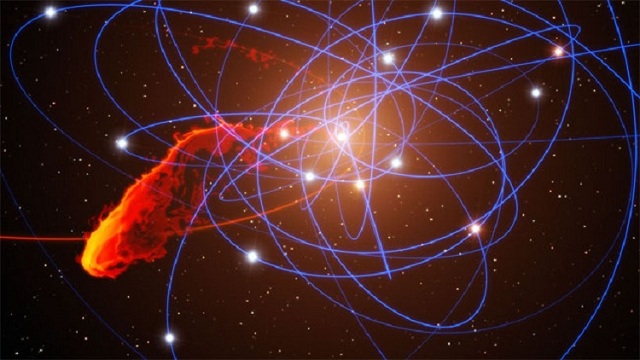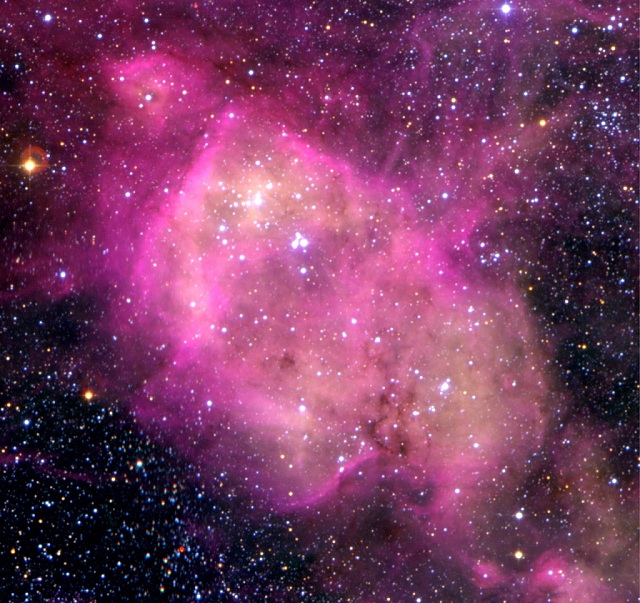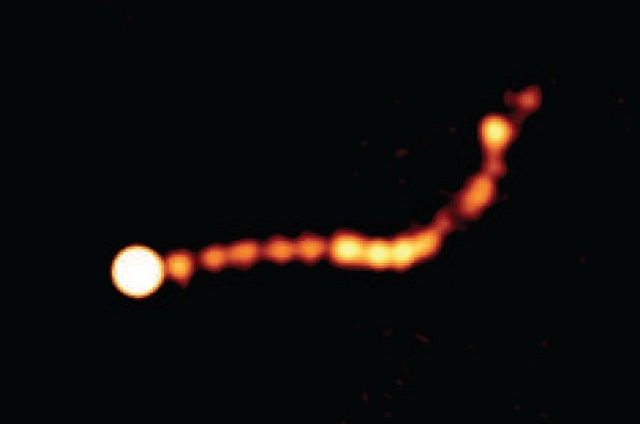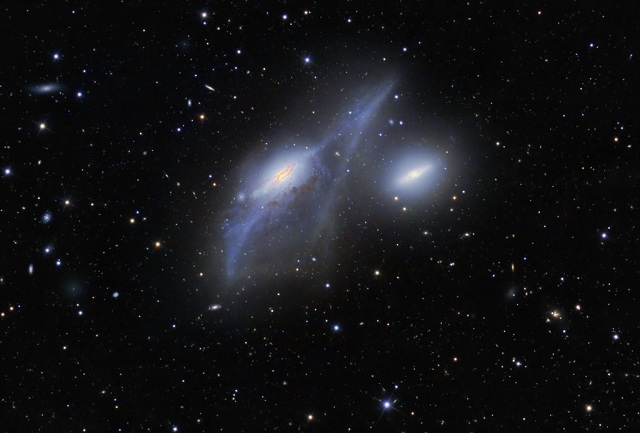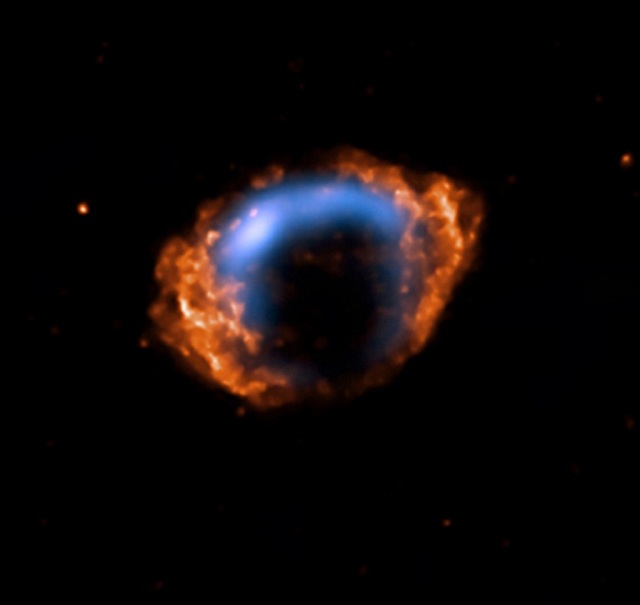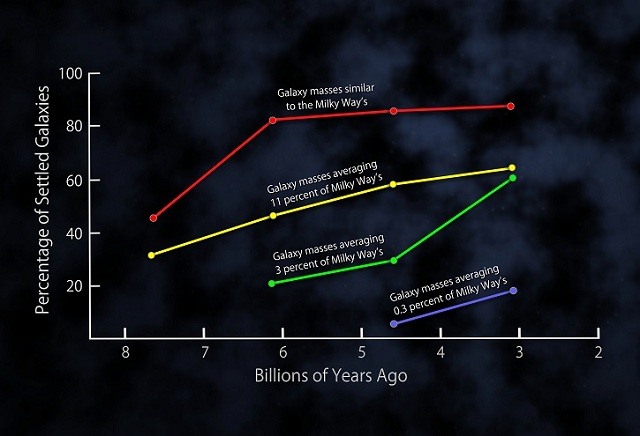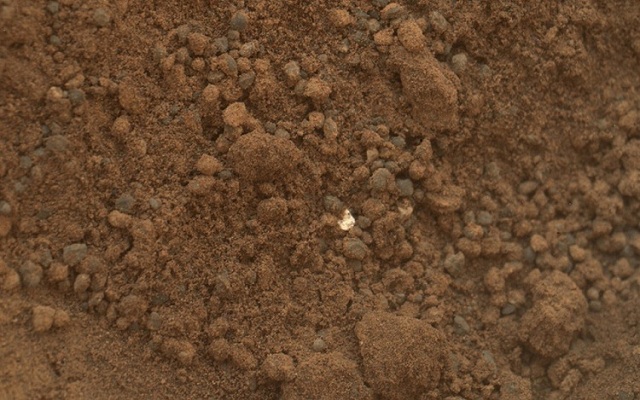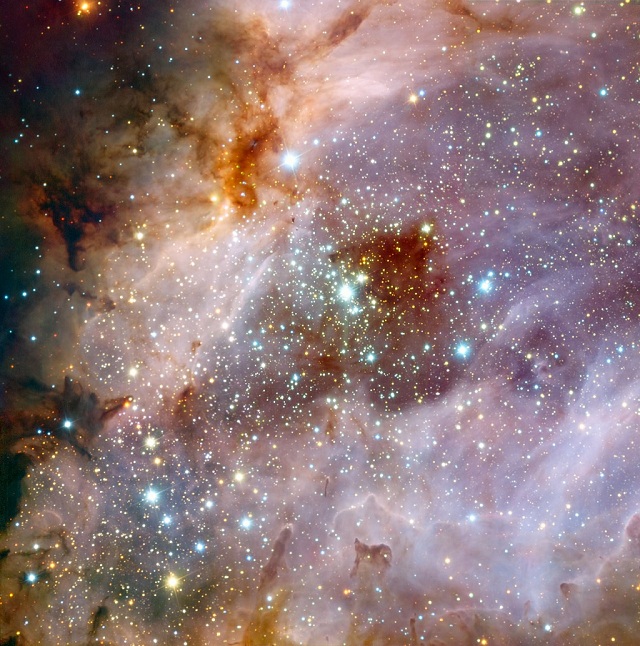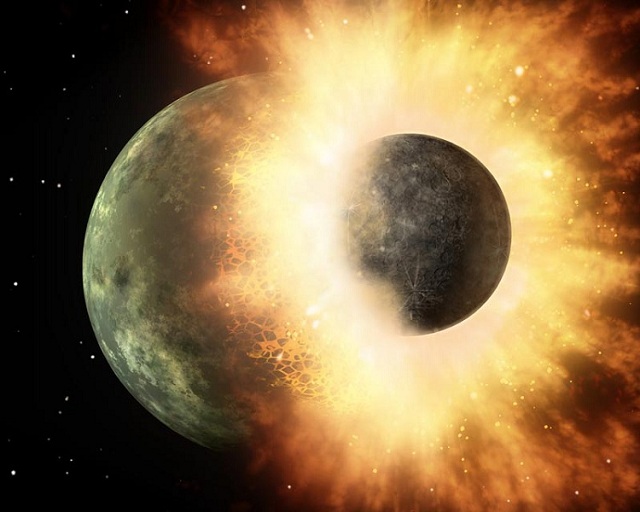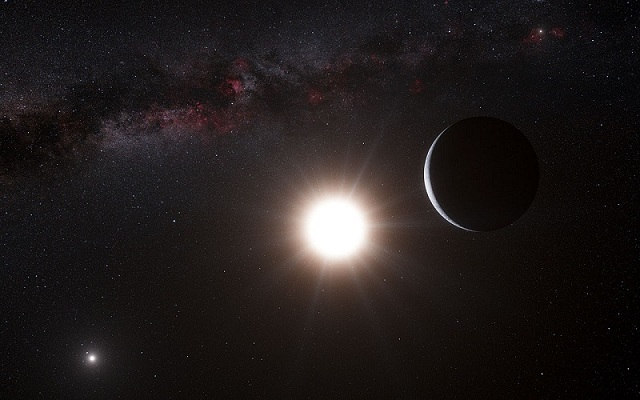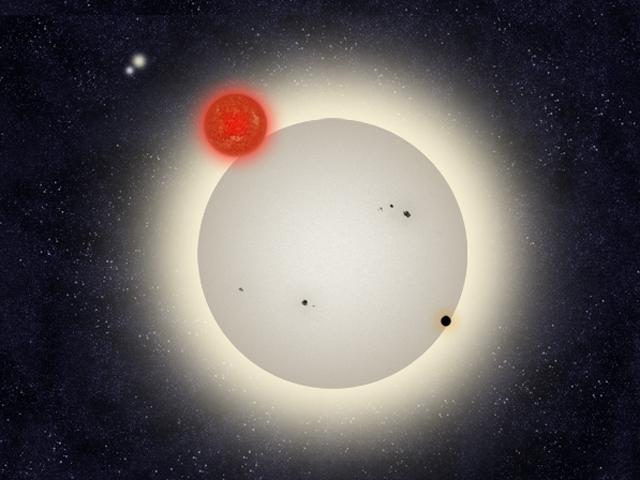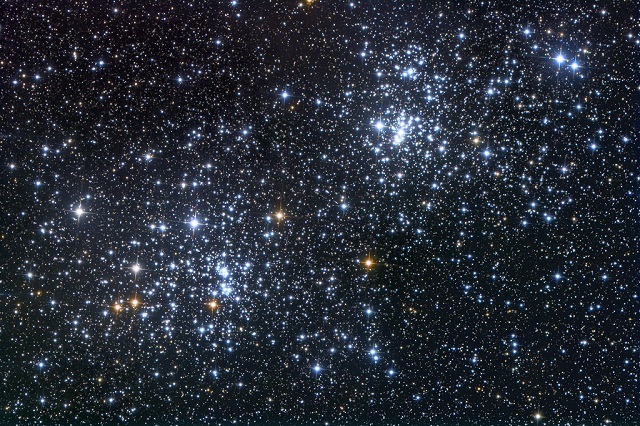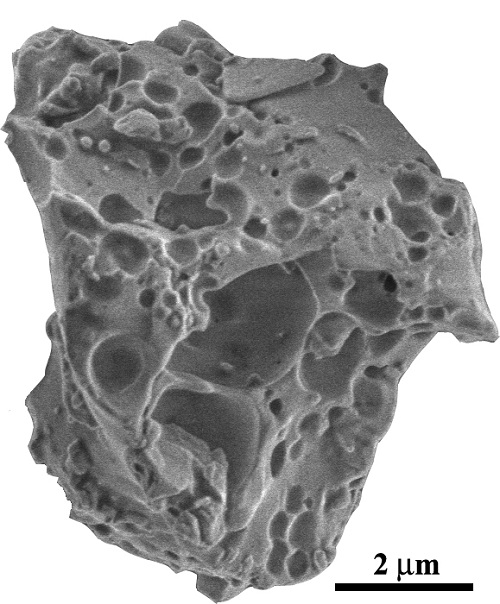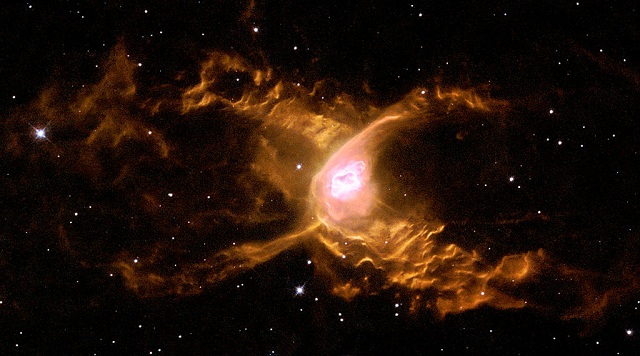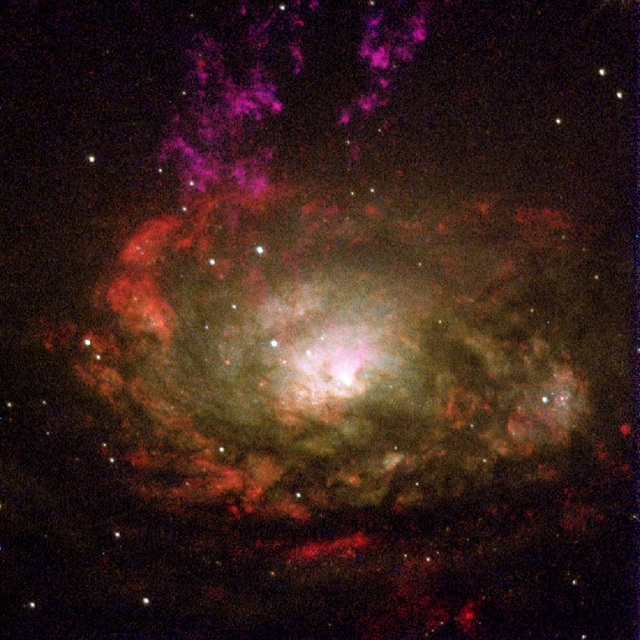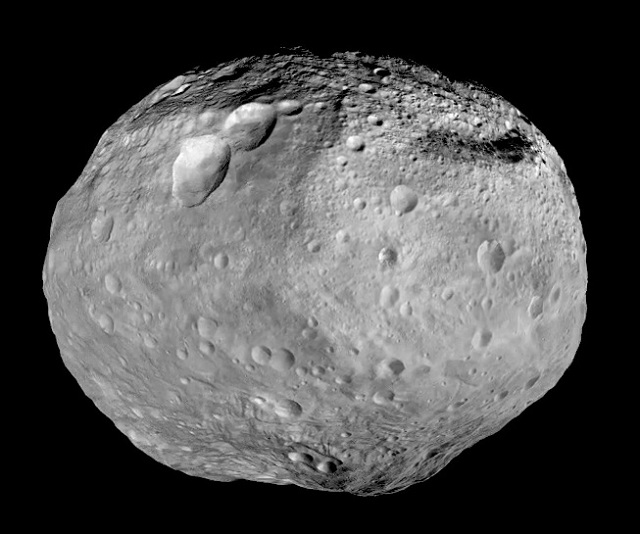
Posts by AnneliesRhemrev:
The Milky Way’s Black Hole is Ready for Lunch
October 23rd, 2012By Annelies Rhemrev
Get ready for a fascinating eating experience in the center of our galaxy.
The event involves a supermassive black hole that may devour much of an approaching cloud of dust and gas known as G2.
Simulations of the dust and gas cloud G2 on its orbit around the Milky Way central black hole SgrA*. Image Credit: M. Schartmann and L. Calcada/ European Southern Observatory and Max-Planck-Institut fur Extraterrestrische Physik A supercomputer simulation prepared by two Lab physicists and a former postdoc suggests that some of G2 will survive, although its surviving mass will be torn apart, leaving it with a different shape and questionable fate.
The findings are the work of computational physicist Peter Anninos and astrophysicist Stephen Murray, both of AX division within the Weapons and Complex Integration Directorate (WCI), along with their former postdoc Chris Fragile, now an associate professor at the College of Charleston in South Carolina, and his student, Julia Wilson.
They came up with six simulations, using the Cosmos++ computer code, which required more than 50,000 computing hours on 3,000 processors on the Palmetto supercomputer at Clemson University in Columbia, S.C.
Previous simulations of the upcoming event had been done in two-dimensions, but the Cosmos++ code includes 3D capability, as well as a unique “moving mesh” enhancement, allowing the simulation to more-efficiently follow the cloud’s progression toward the black hole.
The black hole is known as Sgr A*. “Sgr” is the abbreviation for Sagittarius, the constellation near the center of the Milky Way. Most galaxies have a supermassive black hole at their center, some thousands of times bigger than this one.
“While this one is 3-to-4 million times as big as our Sun, it has been relatively quiet,” according to Murray. “It’s not getting fed very much.” Contrary to their name, black holes can appear very bright. That’s because gas orbiting them loses energy via friction, getting hotter and brighter as it spirals inward before falling into the black hole.

Three-dimensional, volume visualization spanning the period 2010 to 2020, of the gas and dust cloud as it approaches the Sgr A* black hole near the center of the Milky Way galaxy
The composition of the G2 cloud is still a mystery.
Astronomers originally noticed something in the region in 2002, but the first detailed determinations of its size and orbit came only this year. The dust in the cloud has been measured at about 550 degrees Kelvin, approximately twice as hot as the surface temperature on Earth. The gas, mostly hydrogen, is about 10,000 degrees Kelvin, or almost twice as hot as the surface of the Sun.
Its origin is still unknown.
Murray says: “The speculation ranges from it having been an old star that had kind of a burp and lost some of its outer atmosphere, to something that was trying to be a planet and couldn’t quite manage it because the environment was too hot.”
As the cloud approaches the black hole and begins to fall into what Murray describes as “a gravity well” beginning next September, it will begin to shed energy, causing it to heat to incredibly high temperatures, visible to radio and X-ray telescopes on Earth as well as orbiting satellites such as NASA’s Chandra X-ray Observatory.
But it won’t be a collision course.
The point at which a stellar object can no longer escape being swallowed by a black hole is known as the Schwarzschild radius, a quantity whose value depends on the black hole’s mass, the speed of light and the gravitational constant.
The cloud will actually pass far enough away that it will escape the point of no return by approximately 2,200 Schwarzschild radii, which in this case is about 200 times as far as Earth is from the Sun.
But the supercomputer simulations show that the cloud will not survive the encounter.
According to Anninos: “There’s too much dynamical friction that it experiences through hydrodynamic instabilities and tidal stretching from the black hole. So a lot of its kinetic energy and angular momentum will be dissipated away and it will just sort of break up into some sort of incoherent structure. Much of it will join the rest of the hot accretion disk around the black hole, or just fall and get captured by the black hole. It will lose a lot of its energy but not all of it. It will become so diffuse that it’s unlikely that any remnant of the gas will continue on its orbital track.”
The close encounter will take several months. The entire event is predicted to last less than a decade.
The simulation shows the cloud modeled as a simple gas sphere, near the point in its orbit where it was first discovered. As it approaches Sgr A*, a process known as tidal stretching increasingly distorts the cloud. By the end of 2012, the cloud will be nearly five times longer than it is wide.
Along with tidal stretching, the cloud also experiences resistance in the form of ram pressure as it tries to plow through the hot interstellar gas that already fills the space around Sgr A*. The interactions of G2 with this background gas cause further disruptions to the cloud from Rayleigh-Taylor and Kelvin-Helmholtz instabilities. Collectively, these effects act to strip some material from the cloud and feed it into Sgr A*.
An article describing the simulation research will appear in an upcoming issue of the Astrophysical Journal.
Source: The Lawrence Livermore National Laboratory
Read more stories on Anne’s Astronomy News
Anne’s Image of the Day: Nebula N 164
October 23rd, 2012By Annelies Rhemrev
October 23, 2012
N 164, an emission nebula in the LMC
Image Credit: ESO
For a larger image click here.
N 164 is a bright emission nebula and star-forming cloud, located within the Large Magellanic Cloud — an irregular satellite galaxy to our Milky Way galaxy — about 157,000 light-years away in the constellation of Dorado.
New hot stars inside the nebula are forming out of interstellar gas and dust, and they are causing the nebula to glow. The heating of the gas by these stars increases the pressure, and this causes the nebula to expand, pushing outwards against their surroundings. When you look carefully at N 164, the nebula reveals locations where the expansion is encountering resistance by denser clouds of gas, producing bright, thin rims.
See more images on Anne’s Astronomy News
High-Speed Cosmic Jet of Two Million Lights-Years Long Found
October 22nd, 2012By Annelies Rhemrev
Blasting over two million lights-years from the center of a distant galaxy is a supersonic jet of material that looks strikingly similar to the afterburner flow of a fighter jet, except in this case the jet engine is a supermassive black hole and the jet material is moving at nearly the speed of light.
The jet known as ‘PKS 0637-752’ as seen by the Australia Telescope Compact Array (ATCA) in New South Wales, Australia clearly showing the shock diamond-like shapes in the two million light-year long structure. Image Credit: Dr Leith Godfrey, ICRAR and Dr Jim Lovell, UTas.
Research published over the weekend in the Astrophysical Journal Letters shows the galaxy-scale jet to have bright and dark regions, similar to the phenomenon in an afterburner exhaust called ‘shock diamonds.’
A new image of the previously studied jet reveals regularly spaced areas that are brighter than the rest of the jet in a pattern that echoes the way the afterburner from a jet engine has brighter diamond-shaped areas in its general glow.
“One intriguing possibility is that the pattern we see in this cosmic jet is produced in the same way as the pattern in the exhaust from fighter jet engines,” said Dr Leith Godfrey, from the Curtin University node of The International Centre for Radio Astronomy Research.
Dr Godfrey said the jets are produced when material falls onto a supermassive black hole at the center of a galaxy, but many details beyond that remain unknown.
“Massive jets like this one have been studied for decades, since the beginning of radio astronomy, but we still don’t understand exactly how they are produced or what they’re made of,” he said.
“If the brighter patches are caused by the same process in astronomical jets as they are in earthly jet engines, then the distance between them can give us important information about the power of the jet and the density of the surrounding space.”
Dr Godfrey said that jets like the one he studied are the largest objects in the Universe, about 100 times larger than the Milky Way.
“If we want to understand how galaxies form and grow, we need to understand these jets. They are extremely powerful and are believed to stop stars forming in their parent galaxy, limiting how big the galaxies can grow and effecting how the Universe looks today,” he said.
“This new image of the jet shows detail we’ve never seen before and the pattern we revealed provides a clue to how jets like this one work,” said Dr Jim Lovell, a co-author from the University of Tasmania.
“This particular jet emits a lot of X-rays, which is hard to explain with our current models. Our new find is a step forward in understanding how these giant objects emit so much X-Ray radiation, and indirectly, will help us understand how the jet came to be.”
Dr Lovell said that the image had been taken using the CSIRO Australia Telescope Compact Array radio telescope in New South Wales.
ICRAR is a joint venture between Curtin University and The University of Western Australia providing research excellence in the field of radio astronomy.
The publication “Periodic Structure in the megaparsec-scale jet of PKS 0637-752” by Leith Godfrey et al. has been published in The Astrophysical Journal Letters, Vol 758 Number 2. http://iopscience.iop.org/2041-8205/758/2/L27
Source: The International Centre for Radio Astronomy Research (ICRAR)
Read more stories on Anne’s Astronomy News
Anne’s Image of the Day: The Eyes
October 22nd, 2012By Annelies Rhemrev
October 22, 2012
The Eyes, a galaxy pair in Virgo
Image Credit & Copyright: Ken Crawford, Rancho Del Sol Observatory (http://www.imagingdeepsky.com and www.aicccd.com)
For larger image click here.
The Eyes (also called Markarian’s Eyes) are two galaxies (NGC 4438 (left) and NGC 4435), about 52 million light-years away and some 100,000 light-years apart in the constellation Virgo. They are rather prominent in Markarian’s Chain, a string of galaxies in the central core of the Virgo Galaxy Cluster.
NGC 4438, the larger galaxy, is thought to have once been a spiral galaxy that was strongly deformed by collisions in the relatively recent past. It has a highly distorted disk and long tidal tails. A lane of obscuring dust is visible just below its weak nucleus and young stars are visible to the left of its center.
NGC 4435 is a compact barred lenticular galaxy with a bright core of more than 50% of its diameter, and has a relatively young stellar population on its central regions (age of 190 million years). It seems to be almost devoid of gas and dust, but does have a very faint extension in the opposite direction of NGC 4438. It appears completely free of any tidal disturbances.
There is a debate about whether NGC 4435 and NGC 4438 are interacting.
According to one theory NGC 4435 is to blame. The effects seen in NGC 4438 were caused when the two galaxies came within about 16,000 light-years of each other about 100 million years ago. But while the more massive NGC 4438 was damaged, the smaller NGC 4435 was significantly more affected by the collision. Gravitational tides from this close encounter are probably responsible for ripping away their stars, gas, and dust. NGC 4438 managed to hold on to much of the material torn out in the collision, while material from NGC 4435 was more easily lost.
Another theory is that the giant elliptical galaxy Messier 86, further away from The Eyes, was responsible for the damage to NGC 4438. Recent observations have found filaments of ionized hydrogen gas connecting the two large galaxies, suggesting that they may have collided in the past.
In rich clusters of galaxies, such as the Virgo Cluster, galaxy collisions are fairly frequent, so it’s possible NGC 4438 suffered from encounters with both NGC 4435 and Messier 86.
There is uncertainty surrounding the energy mechanism that heats the nuclear source of NGC 4438; this may be a starburst region, or an active galactic nucleus powered by a supermassive black hole.
In this image you can also see many distant background galaxies.
Read more on Anne’s Astronomy News
Anne’s Image of the Day: Supernova remnant G1.9+0.3
October 21st, 2012By Annelies Rhemrev
October 21, 2012
G1.9+0.3, the youngest known supernova remnant in the Milky
Image Credit: X-ray (NASA/CXC/NCSU/S.Reynolds et al.); Radio (NSF/NRAO/VLA/Cambridge/D.Green et al.); Infrared (2MASS/UMass/IPAC-Caltech/NASA/NSF/CfA/E.Bressert)
For a larger image click here.
Supernova remnant G1.9+0.3 was created by the explosion of a star about 25,000 light-years away in the constellation Sagittarius, near its border with Ophiuchus. Although the explosion occurred about 25,000 years ago, its light reached Earth just about 110 years ago (around the year 1900), what makes it the youngest known supernova remnant in the Milky Way Galaxy. (Prior to this discovery in 1984, the youngest-known Milky Way supernova remnant was Cassiopeia A, at about 330 years.) The expanding remnant is now some 2.6 light-years across.
The radio image from NRAO’s Very Large Array (VLA) obtained in 1985 (shown in blue) is overlaid by NASA’s Chandra X-ray Observatory image from early 2007 (in orange). The remnant had expanded by a surprisingly large amount, about 16% since 1985. The difference in size between the two images gives clear evidence for expansion of the original supernova explosion. This rapid expansion and young age for G1.9+0.3 was confirmed by a new VLA image obtained in early 2008.
The original supernova explosion – most likely a Type Ia supernova – was not seen in optical light about 145 years ago because it occurred close to the center of the Galaxy, and is embedded in a dense field of gas and dust. This made the supernova about a trillion times fainter, in optical light, than if it had been unobscured. Fortunately, the expanding gas cloud from the explosion shines brightly in radio waves and X-rays for thousands of years. X-ray and radio telescopes can see through all that obscuration and show astronomers what they had been missing otherwise.
Supernova remnants are caused when the debris thrown outwards by the explosion crashes into surrounding material, generating a shell of hot gas and high-energy particles that glows brightly in X-rays, radio waves and other wavelengths for thousands of years. (A Type Ia supernova is a result from the violent explosion of a white dwarf star.)
In the case of G1.9+0.3 the material is expanding outwards at almost 35 million miles (56 million kilometers) per hour, or about 5% the speed of light, an unprecedented expansion speed for a supernova remnant. Another superlative for G1.9+0.3 is that it has generated the most energetic electrons ever seen in a supernova remnant.
Astronomers regularly observe supernovae in other galaxies like ours. Based on those observations, researchers estimate about three explode every century in the Milky Way. If the supernova rate estimates are correct, there should be the remnants of about 10 supernova explosions that are younger than Cassiopeia A.
Read more on Anne’s Astronomy News
A Surprising Trend in Galaxy Evolution Uncovered (with Videos)
October 20th, 2012By Annelies Rhemrev
A comprehensive study of hundreds of galaxies observed by the Keck telescopes in Hawaii and NASA’s Hubble Space Telescope has revealed an unexpected pattern of change that extends back 8 billion years, or more than half the age of the Universe.
This plot shows the fractions of settled disk galaxies in four time spans, each about 3 billion years long. There is a steady shift toward higher percentages of settled galaxies closer to the present time. At any given time, the most massive galaxies are the most settled. More distant and less massive galaxies on average exhibit more disorganized internal motions, with gas moving in multiple directions, and slower rotation speeds. Image Credit: NASA’s Goddard Space Flight Center
“Astronomers thought disk galaxies in the nearby Universe had settled into their present form by about 8 billion years ago, with little additional development since,” said Susan Kassin, an astronomer at NASA’s Goddard Space Flight Center in Greenbelt, Md., and the study’s lead researcher. “The trend we’ve observed instead shows the opposite, that galaxies were steadily changing over this time period.”
Today, star-forming galaxies take the form of orderly disk-shaped systems, such as the Andromeda Galaxy or the Milky Way, where rotation dominates over other internal motions. The most distant blue galaxies in the study tend to be very different, exhibiting disorganized motions in multiple directions. There is a steady shift toward greater organization to the present time as the disorganized motions dissipate and rotation speeds increase. These galaxies are gradually settling into well-behaved disks.
Blue galaxies — their color indicates stars are forming within them — show less disorganized motions and ever-faster rotation speeds the closer they are observed to the present. This trend holds true for galaxies of all masses, but the most massive systems always show the highest level of organization.
Researchers say the distant blue galaxies they studied are gradually transforming into rotating disk galaxies like our own Milky Way.
“Previous studies removed galaxies that did not look like the well-ordered rotating disks now common in the Universe today,” said co-author Benjamin Weiner, an astronomer at the University of Arizona in Tucson. “By neglecting them, these studies examined only those rare galaxies in the distant Universe that are well-behaved and concluded that galaxies didn’t change.”
Rather than limit their sample to certain galaxy types, the researchers instead looked at all galaxies with emission lines bright enough to be used for determining internal motions. Emission lines are the discrete wavelengths of radiation characteristically emitted by the gas within a galaxy. They are revealed when a galaxy’s light is separated into its component colors. These emission lines also carry information about the galaxy’s internal motions and distance.
The team studied a sample of 544 blue galaxies from the Deep Extragalactic Evolutionary Probe 2 (DEEP2) Redshift Survey, a project that employs Hubble and the twin 10-meter telescopes at the W. M. Keck Observatory in Hawaii. Located between 2 billion and 8 billion light-years away, the galaxies have stellar masses ranging from about 0.3 percent to 100 percent of the mass of our home galaxy.
The Milky Way galaxy must have gone through the same rough-and-tumble evolution as the galaxies in the DEEP2 sample, and gradually settled into its present state as the Sun and Solar System were being formed.
In the past 8 billion years, the number of mergers between galaxies large and small has decreased sharply. So has the overall rate of star formation and disruptions of supernova explosions associated with star formation. Scientists speculate these factors may play a role in creating the evolutionary trend they observe.
Now that astronomers see this pattern, they can adjust computer simulations of galaxy evolution until these models are able to replicate the observed trend. This will guide scientists to the physical processes most responsible for it.
A paper describing these findings will be published today in The Astrophysical Journal.
Source: The National Aeronautics and Space Administration (NASA)
Read more on Anne’s Astronomy News
Anne’s Image of the Day: The Andromeda Galaxy
October 20th, 2012By Annelies Rhemrev
October 20, 2012
The Andromeda Galaxy, our large neighbour galaxy
Image Credit & Copyright: Dieter Beer (http://www.starhopper.at/) & Patrick Hochleitner (http://www.photonhunter.at)
For a larger image click here.
The Andromeda Galaxy (Messier 31 or NGC 224) is a barred spiral galaxy of more than 220,000 light-years across, located approximately 2.54 million light-years away in the Andromeda constellation. It is the largest galaxy of the Local Group, which also contains the Milky Way, the Triangulum Galaxy (M33), and about 30 other smaller galaxies.
Although the largest, Andromeda may not be the most massive, as recent findings suggest that the Milky Way contains more dark matter and could be the most massive of the two. Mass estimates for Andromeda (including dark matter) give a value of approximately 1.2 trillion solar masses compared to 1.9 trillion solar masses for the Milky Way. But, Andromeda has a higher stellar density than that of the Milky Way. Andromeda contains one trillion stars: at least twice the number of stars in our Milky Way, which is estimated to be 200–400 billion. There may be several stellar black holes or neutron stars in Andromeda, which are heating incoming gas to millions of kelvins and emitting X-rays.
Andromeda appears to have also significantly more common stars than the Milky Way, and the estimated luminosity of Andromeda is about 25% higher than that of our own galaxy. However the rate of star formation in the Milky Way is much higher, with Andromeda producing only about one solar mass per year compared to 3–5 solar masses for the Milky Way. Andromeda contains two distinct populations of stars based on their metallicity, young, high velocity stars in the disk and older, red stars in the bulge.
The rate of supernovae in the Milky Way is also double that of Andromeda. This suggests that Andromeda once experienced a great star formation phase, but is now in a relative state of quiescence, whereas the Milky Way is experiencing more active star formation. Should this continue, the luminosity in the Milky Way may eventually overtake that of Andromeda.
Andromeda has a bright yellow nucleus, dark winding dust lanes and young star clusters, while reddish star-forming regions are dotting the clockwise wound-up spiral arms. These arms appear to be tightly wound, although they are more widely spaced than in our galaxy. There are two continuous trailing arms that are separated from each other by a minimum of about 13,000 light-years. These can be followed outward from a distance of roughly 1,600 light-years from the core.
Andromeda’s nucleus consists of two concentrations separated by 4.9 light-years. The brighter concentration, designated as P1, is offset from the center of the galaxy and has no black hole at its center. The dimmer concentration, P2, falls at the true center of the galaxy and does contain a supermassive black hole. The velocity of material spiralling around it is about 160 km/s.
There are approximately 460 globular clusters in Andromeda, including a dense and compact star cluster at its very center. The most massive of these clusters, Mayall II, has a greater luminosity than any other known globular cluster in the Local Group of galaxies. It contains several million stars, and is about twice as luminous as Omega Centauri, the brightest known globular cluster in the Milky Way. Mayall II (G1) has several stellar populations and a structure too massive for an ordinary globular. As a result, some consider Mayall II to be the remnant core of a dwarf galaxy that was consumed by Andromeda in the distant past.
Unlike the globular clusters of the Milky Way, that show a relatively low age dispersion, Andromeda’s globular clusters have a much larger range of ages: from systems as old as the galaxy itself to much younger systems, with ages between a few hundred million years to five billion years.
In 2005, astronomers discovered a completely new type of star cluster in Andromeda. The new-found clusters contain hundreds of thousands of stars, a similar number of stars that can be found in globular clusters. What distinguishes them from the globular clusters is that these stars are much larger (several hundred light-years across) and hundreds of times less dense. The distances between the stars are, therefore, much greater within the newly discovered extended clusters.
In 2009, the first planet has been discovered in the Andromeda Galaxy. This exoplanet was detected using a technique called microlensing, which is caused by the deflection of light by a massive object.
Both Andromeda and the Milky Way are likely to have accreted and assimilated about 1–200 small galaxies during the past 12 billion years. The most important event in Andromeda’s past history was the merger with another galaxy that took place about 8 billion years ago. This violent collision formed most of its (metal-rich) galactic halo and extended disk and during that epoch Andromeda’s star formation would be very high, to the point of becoming a Luminous infrared galaxy during roughly 100 millon years.
Andromeda and the Triangulum Galaxy had a very close passage 2-4 billion years ago. This event produced high levels of star formation across the Andromeda Galaxy’s disk -even some globular clusters- and disturbed Andromeda’s outer disk.
While there has been activity during the last 2 billion years, this has been much lower than during the past. There have been interactions with satellite galaxies like M32, M110, or others that have already disappeared, absorbed by Andromeda that have formed structures like Andromeda’s Giant Stellar Stream and a merger roughly 100 million years ago that is behind a counter-rotating disk of gas found in the center of M31 as well as the presence there of a relatively young (100 million years) stellar population. During this epoch, star formation through Andromeda’s disk decreased to the point of nearly shutting down to increasing again relatively recently.
The Andromeda Galaxy is approaching the Milky Way at about 100 to 140 kilometres per second (400 light-years every million years). The Andromeda Galaxy and the Milky Way are thus expected to collide in about 3.75 to 4.5 billion years. A likely outcome of the collision is that the galaxies will merge to form a giant elliptical galaxy. If the galaxies do not merge, there is a small chance that the Solar System could be ejected from the Milky Way or join Andromeda.
Like the Milky Way, the Andromeda Galaxy has satellite galaxies, consisting of 14 known dwarf galaxies. The best known and most observed satellites are M32 and M110. M32 may once have been a larger galaxy that had its stellar disk removed by Andromeda, when they had a close encounter more than 200 million years ago, and underwent a sharp increase of star formation in the core region, which lasted until the relatively recent past.
M110 also appears to be interacting with M31, and astronomers have found in the halo of Andromeda a stream of metal-rich stars that appear to have been stripped from both of these satellite galaxies. M110 contains a dusty lane, which may indicate recent or ongoing star formation.
Because Andromeda is one of the brightest Messier objects, it is visible to the naked eye on moonless nights even when viewed from areas with moderate light pollution. However, only the brighter central region is visible to the naked eye or when viewed using binoculars or a small telescope.
Read more on Anne’s Astronomy News
Mysterious Bright Particles on Mars Found
October 19th, 2012By Annelies Rhemrev
NASA’s Mars rover Curiosity has ingested its first solid sample into an analytical instrument inside the rover, a capability at the core of the two-year mission. The rover’s Chemistry and Mineralogy (CheMin) instrument is analyzing this sample to determine what minerals it contains.
This image shows part of the small pit or bite created when NASA’s Mars rover Curiosity collected its second scoop of Martian soil at a sandy patch called “Rocknest”. Image Credit: NASA/JPL-Caltech/MSSS
“We are crossing a significant threshold for this mission by using CheMin on its first sample,” said Curiosity’s project scientist, John Grotzinger of the California Institute of Technology in Pasadena. “This instrument gives us a more definitive mineral-identifying method than ever before used on Mars: X-ray diffraction. Confidently identifying minerals is important because minerals record the environmental conditions under which they form.”
The sample is a sieved portion — about as much material as in a baby aspirin — from the third scoop collected by Curiosity as a windblown patch of dusty sand called “Rocknest.” The rover’s robotic arm delivered the sample to CheMin’s opened inlet funnel on the rover’s deck on Oct. 17.

First Sample Placed on Curiosity’s Observation Tray: The robotic arm on NASA’s Mars rover Curiosity delivered a sample of Martian soil to the rover’s observation tray for the first time during the mission’s 70th Martian day, or sol (Oct. 16, 2012). This image taken later that same sol by the rover’s left Mast Camera shows the sample on the tray. The tray is 3 inches (7.8 centimeters) in diameter. The sample came from the third scoopful of material collected at the “Rocknest” patch of windblown dust and sand. Image Credit: NASA/JPL-Caltech/MSSS
The previous day, the rover shook the scooped material inside sample-processing chambers to scrub internal surfaces of any residue carried from Earth. One earlier scoopful was also used for cleaning. Additional repetitions of this cleaning method will be used before delivery of a future sample to the rover’s other internal analytic instrument, the Sample Analysis at Mars investigation, which studies samples’ chemistry.
Various small bits of light-toned material on the ground at Rocknest have affected the rover’s activities in the past several days. One piece about half an inch (1.3 centimeters) long was noticed on Oct. 7. The rover team postponed use of the robotic arm for two days while investigating this object, and assessed it to be debris from the spacecraft.

Three bite marks left in the Martian ground by the scoop on the robotic arm of NASA’s Mars rover Curiosity are visible in this image taken by the rover’s right Navigation Camera during the mission’s 69th Martian day, or sol (Oct. 15, 2012). Image Credit: NASA/JPL-Caltech
Images taken after Curiosity collected its second scoop of Rocknest material on Oct. 12 showed smaller bits of light-toned material in the hole dug by the scooping action. This led to discarding that scoopful rather than using it to scrub the processing mechanisms. Scientists assess these smaller, bright particles to be native Martian material, not from the spacecraft.
“We plan to learn more both about the spacecraft material and about the smaller, bright particles,” said Curiosity Project Manager Richard Cook of NASA’s Jet Propulsion Laboratory, Pasadena. “We will finish determining whether the spacecraft material warrants concern during future operations. The native Mars particles become fodder for the mission’s scientific studies.”
During a two-year prime mission, researchers are using Curiosity’s 10 instruments to assess whether the study area has ever offered environmental conditions favorable for microbial life.
Source: Jet Propulsion Laboratory (JPL)
Read more on Anne’s Astronomy News
Anne’s Image of the Day: Messier 17
October 19th, 2012By Annelies Rhemrev
October 19, 2012
Messier 17 (the Omega or Swan Nebula), the central part
Image Credit: ESO/R. Chini
For a larger image click here.
Messier 17 (also catalogued NGC 6618, and known as the Omega, Swan, Horseshoe, and Lobster Nebula) is a diffuse emission nebula and H II (star-forming) region, located roughly 5,500 light-years away in the heart of the Milky Way in the constellation of Sagittarius (the Archer). While the bright nebula seems to be roughly 15 light-years across, the total gaseous cloud extends to at least 40 light years.
It is one of the brightest and most massive star-forming regions of our galaxy. The total region of gas, dust and hot young stars has a mass of 30,000 solar masses, while the mass of the bright part of Messier 17 is an estimated 800 solar masses. This image of its central region shows vast clouds of gas and dust illuminated by the intense radiation from young stars.
In the centre of Messier 17 is a cluster of 35 massive young stars whose intense radiation makes the surrounding hydrogen gas glow. However, the actual number of stars in the nebula is much higher -up to 800, plus more than 1000 stars in formation on its outer regions. With an age of just 1 million years it is one of the youngest star clusters known.
To the lower right of the cluster is a huge cloud of molecular gas. At visible wavelengths, dust grains in the cloud obscure our view, but by observing in infrared light, the glow of the hydrogen gas behind the cloud can be seen shining faintly through.
Hidden in this region, which has a dark reddish appearance, the astronomers found the opaque silhouette of a disk of gas and dust. Although it is small in this image, the disc has a diameter of about 20,000 AU, dwarfing our Solar System (1 AU is the distance between the Earth and the Sun). It is thought that this disc is rotating and feeding material onto a central protostar — an early stage in the formation of a new star.
It is a popular target for amateur astronomers, who can obtain good quality images using small telescopes. With a dark observing site and a keen pair of eyes Messier 17 can even be seen with the naked eye.
This composite image is created by using data from ESO’s Very Large Telescope (VLT), at the Paranal Observatory in Chile, made at near-infrared wavelengths with the ISAAC instrument.
Read more on Anne’s Astronomy News
The Moon was Formed in Massive Planetary Collision
October 18th, 2012By Annelies Rhemrev
New study traces Moon evaporation and leads to questions about why Earth has so much water
Fresh examinations of lunar rocks gathered by Apollo mission astronauts have yielded new insights about the Moon’s chemical makeup as well as clues about the giant impacts that may have shaped the early beginnings of Earth and the Moon.
A celestial body about the size of the moon slams into a planetary body the size of Mercury in this artist’s conception. Image Credit: NASA/JPL-Caltech
Geochemist James Day of Scripps Institution of Oceanography at UC San Diego and colleagues Randal Paniello and Frédéric Moynier at Washington University in St. Louis used advanced technological instrumentation to probe the chemical signatures of moon rocks obtained during four lunar missions and meteorites collected from the Antarctic. The data revealed new findings about elements known as volatiles, which offer key information about how planets may have formed and evolved.
The researchers discovered that the volatile element zinc, which they call “a powerful tracer of the volatile histories of planets,” is severely depleted on the Moon, along with most other similar elements. This led them to conclude that a “planetary-scale” evaporation event occurred in the Moon’s history, rather than regional evaporation events on smaller scales.
“This is compelling evidence of extreme volatile depletion of the Moon,” said Day. “How do you remove all of the volatiles from a planet, or in this case a planetary body? You require some kind of wholesale melting event of the Moon to provide the heat necessary to evaporate the zinc.”
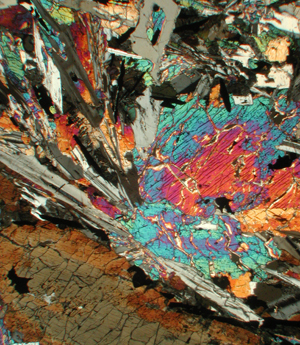
A cross-polarized transmitted-light image of a polished section of Apollo sample 12021.
According to Day, a gigantic planetary collision resulting in global transformations might be responsible for eradicating such elements. Day recently led a study in the journal Nature Geoscience that showed how such a collision might have brought precious metals such as gold and platinum to Earth, likely just after the solar system formed
To derive the findings published in the new study, the researchers employed a mass spectrometer device, an advanced instrument that precisely measures the ratios of isotopes of a particular chemical element, which Day said revealed information not accessible even five years ago. Comparing the zinc composition of moon rocks with rocks from Earth and Mars revealed severe depletions in the lunar samples.
The researchers argue in the paper that such a disparity points to a large-scale evaporation of zinc, “most likely in the aftermath of the Moon-forming event, rather than small-scale processes during volcanic processes.”

Geochemist James Day of Scripps Institution of Oceanography at UC San Diego
The next stage of this research, Day said, is to investigate why Earth is not similarly depleted of zinc and similar volatile elements, a line of exploration which could lead to answers about how and why the Earth is mostly covered by water.
“Where did all the water on Earth come from?” asked Day. “This is a very important question because if we are looking for life on other planets we have to recognize that similar conditions are probably required. So understanding how planets obtain such conditions is critical for understanding how life ultimately occurs on a planet.”
Although the Apollo mission rocks were collected more than 40 years ago, the new study proves they are still offering new insights.

Apollo 17 astronaut Jack Schmitt at the lunar rover near Shorty Crater, Taurus-Littrow valley of the Moon. Image courtesy of J. Schmitt, the Apollo 17 crew and NASA
“They still have a lot of science to be done on them and that’s exciting,” said Day. “Hopefully these kinds of results will help push for future sample collection missions to try to more fully understand the moon.”
The results are published in today’s issue of the journal Nature.
Source: The University of California – San Diego
Read more on Anne’s Astronomy News
Anne’s Image of the Day: The Triangulum Galaxy
October 18th, 2012By Annelies Rhemrev
October 18, 2012
The Triangulum Galaxy, a nearby spiral galaxy
Image Credit & Copyright: Roth Ritter, Dark Atmospheres Astrophotography (http://www.darkatmospheres.com/astro)
For a larger image click here.
The Triangulum Galaxy (catalogued as Messier 33 or NGC 598) is a spiral galaxy, located approximately 3 million light-years away in the constellation Triangulum. With a diameter of about 50,000 light years (half the diameter of the Milky Way), the Triangulum galaxy is the third largest member of the Local Group (a group of galaxies which also contains the Milky Way, Andromeda and about 30 other smaller galaxies). However, the faintest outlayers seem to reach more far out, so that the true diameter may be some 82 million light-years. It is approaching our Galaxy at 24 kilometers per second.
Triangulum may be home to 40 billion stars, compared to 400 billion for the Milky Way, and 1 trillion (1000 billion) stars for Andromeda. The mass of the Triangulum Galaxy has been estimated between 10 and 40 billion solar masses.
The disk-shaped galaxy, surrounded by a faint halo, has prominent loosely wound arms of gas and dust that spiral out from the nucleus, and dark dust lanes. There is no bulge at the nucleus. The inner part of the galaxy has two luminous spiral arms, along with multiple spurs that connect the inner to the outer spiral features. The main arms are designated IN (north) and IS (south).
Although Triangulum is classified as unbarred, there may be a weak bar-like structure about the galactic nucleus. The nucleus of this galaxy is an H II (star forming) region, and it contains an ultraluminous X-ray source, which is the most luminous source of X-rays in the Local Group. However, the nucleus does not appear to contain a supermassive black hole.
Triangulum appears to be divided into two distinct components with a different star formation history between the inner disk (within a radius of 30 million light-years) and the outer disk and halo, and may be explained by a scenario of “inside-out” galaxy formation. This occurs when gas is accumulated at large radii later in a galaxy’s life space, while the gas at the core becomes exhausted. The result is a decrease in the average age of stars with increasing radius from the galaxy core.
The northern main spiral arm contains four large HII regions, while the southern arm has greater concentrations of young, hot stars. The estimated rate of supernova explosions in the Triangulum Galaxy is one supernova explosion every 147 years, on average. As of 2008, a total of 100 supernova remnants have been identified in the Triangulum Galaxy, and a majority of the remnants lie in the southern half of the spiral galaxy. Similar asymmetries exist for highly luminous concentrations of massive stars. The center of the distribution of these features is offset about two arc minutes to the southwest.
About 54 globular clusters have been identified in this galaxy, but the actual number may be 122 or more. The confirmed clusters may be several billion years younger than globular clusters in the Milky Way, and cluster formation appears to have increased during the past 100 million years. This increase is correlated with an inflow of gas into the center of the galaxy.
At least 112 variables have been discovered in Triangulum, including 4 novae and about 25 Cepheids. In 2007, a black hole about 15.7 times the mass of the Sun was detected in the galaxy. The black hole, named M33 X-7, orbits a companion star which it eclipses every 3.5 days. It is the largest stellar mass black hole known.
Triangulum’s brightest and largest H II region is NGC 604, a diffuse emission nebula containing ionized hydrogen. As seen from Earth, NGC 604 is located northeast of the galaxy’s central core. It is one of the largest H II regions known, with a diameter of nearly 1500 light-years and a spectrum similar to that of the Orion Nebula.
NGC 604, may have undergone a discrete outburst of star formation about three million years ago. Astronomers counted 200 young hot massive stars (of 15 to 60 solar masses) which have recently formed here. This nebula is the second most luminous HII region within the Local Group of galaxies.
Triangulum is also home to the smaller H II regions NGC 588, 592 and 595. Other prominent HII regions in the galaxy include IC 132, IC 133 and IK 53.
One of the small Local Group member galaxies, the Pisces Dwarf (LGS 3), located a little more than 2 million light-years away, lies at a distance of 913 million light-years from both Triangulum and Andromeda. This means it could be a satellite galaxy of either galaxies. The Pisces Dwarf has a core radius of 483 light-years and 26 million solar masses.
Triangulum itself is a remote but gravitationally bound companion of the Andromeda galaxy. The distance of Triangulum from Andromeda is about 750,000 light-years. Triangulum is moving towards the Andromeda Galaxy and a clumpy stream of hydrogen gas and stars is linking Triangulum with Andromeda, what suggests that a past interaction between these two galaxies took place between 2-8 billion years ago, and a more violent encounter 2.5 billion years in the future.
The fate of the Triangulum Galaxy is unclear, but seems to be linked to its larger neighbor Andromeda. Suggested future scenarios for Triangulum range from being torn apart and absorbed by Andromeda fueling it with hydrogen to form new stars or losing all of its gas—thus, the ability to form new stars—to participating in the collision between the Milky Way and Andromeda, most likely ending orbiting the merger remnant of the latter two galaxies and fusing with it much later. Two other possibilities are a collision with the Milky Way before Andromeda arrives or an ejection out of the Local Group.
The Triangulum Galaxy is one of the most distant objects that can be viewed with the naked eye – under exceptionally good viewing conditions with no light pollution. Through a small telescope, the galaxy looks like a diffuse patch about the same size as the full Moon.
Read more on Anne’s Astronomy News
Earth-Like Planet Around Nextdoor Sun-Like Star Found
October 17th, 2012By Annelies Rhemrev
European astronomers have discovered a planet with about the mass of the Earth orbiting a star in the Alpha Centauri system — the nearest to Earth. It is also the lightest exoplanet ever discovered around a star like the Sun. The planet was detected using the HARPS instrument on the 3.6-metre telescope at ESO’s La Silla Observatory in Chile. The results will appear online in the journal Nature today, 17 October 2012.
This artist’s impression shows the planet orbiting the star Alpha Centauri B, a member of the triple star system that is the closest to Earth. Alpha Centauri B is the most brilliant object in the sky and the other dazzling object is Alpha Centauri A. Our own Sun is visible to the upper right. The tiny signal of the planet was found with the HARPS spectrograph on the 3.6-meter telescope at ESO’s La Silla Observatory in Chile. Image Credit: ESO/L. Calçada/N. Risinger (skysurvey.org)
Alpha Centauri is one of the brightest stars in the southern skies and is the nearest stellar system to our Solar System — only 4.3 light-years away. It is actually a triple star — a system consisting of two stars similar to the Sun orbiting close to each other, designated Alpha Centauri A and B, and a more distant and faint red component known as Proxima Centauri [1]. Since the nineteenth century astronomers have speculated about planets orbiting these bodies, the closest possible abodes for life beyond the Solar System, but searches of increasing precision had revealed nothing. Until now.
“Our observations extended over more than four years using the HARPS instrument and have revealed a tiny, but real, signal from a planet orbiting Alpha Centauri B every 3.2 days,” says Xavier Dumusque (Geneva Observatory, Switzerland and Centro de Astrofisica da Universidade do Porto, Portugal), lead author of the paper. “It’s an extraordinary discovery and it has pushed our technique to the limit!”
The European team detected the planet by picking up the tiny wobbles in the motion of the star Alpha Centauri B created by the gravitational pull of the orbiting planet [2]. The effect is minute — it causes the star to move back and forth by no more than 51 centimetres per second (1.8 km/hour), about the speed of a baby crawling. This is the highest precision ever achieved using this method.

The same image as above, but now annotated.
Alpha Centauri B is very similar to the Sun but slightly smaller and less bright. The newly discovered planet, with a mass of a little more than that of the Earth [3], is orbiting about six million kilometers away from the star, much closer than Mercury is to the Sun in the Solar System. The orbit of the other bright component of the double star, Alpha Centauri A, keeps it hundreds of times further away, but it would still be a very brilliant object in the planet’s skies.
The first exoplanet around a Sun-like star was found by the same team back in 1995 and since then there have been more than 800 confirmed discoveries, but most are much bigger than the Earth, and many are as big as Jupiter [4]. The challenge astronomers now face is to detect and characterise a planet of mass comparable to the Earth that is orbiting in the habitable zone [5] around another star. The first step has now been taken [6].
“This is the first planet with a mass similar to Earth ever found around a star like the Sun. Its orbit is very close to its star and it must be much too hot for life as we know it,” adds Stéphane Udry (Geneva Observatory), a co-author of the paper and member of the team, “but it may well be just one planet in a system of several. Our other HARPS results, and new findings from Kepler, both show clearly that the majority of low-mass planets are found in such systems.”
“This result represents a major step towards the detection of a twin Earth in the immediate vicinity of the Sun. We live in exciting times!” concludes Xavier Dumusque.

This wide-field view of the sky around the bright star Alpha Centauri was created from photographic images forming part of the Digitized Sky Survey 2. The star appears so big just because of the scattering of light by the telescope’s optics as well as in the photographic emulsion. Alpha Centauri is the closest star system to the Solar System. Image Credit: ESO/Digitized Sky Survey 2; Acknowledgement: Davide De Martin
This research was presented in a paper “An Earth mass planet orbiting Alpha Centauri B”, to appear online in the journal Nature today, 17 October 2012.
Notes
[1] The components of a multiple star are named by adding uppercase letters to the name of the star. Alpha Centauri A is the brightest component, Alpha Centauri B is the slightly fainter second star and Alpha Centauri C is the much fainter Proxima Centauri. Proxima Centauri is slightly closer to Earth than A or B and hence is formally the closest star.
[2] HARPS measures the radial velocity of a star — its speed towards or away from the Earth — with extraordinary precision. A planet in orbit around a star causes the star to regularly move towards and away from a distant observer on Earth. Due to the Doppler effect, this radial velocity change induces a shift of the star’s spectrum towards longer wavelengths as it moves away (called a redshift) and a blueshift (towards shorter wavelengths) as it approaches. This tiny shift of the star’s spectrum can be measured with a high-precision spectrograph such as HARPS and used to infer the presence of a planet.
[3] Using the radial velocity method, astronomers can only estimate a minimum mass for a planet as the mass estimate also depends on the tilt of the orbital plane relative to the line of sight, which is unknown. But, from a statistical point of view, this minimum mass is often close to the real mass of the planet.
[4] NASA’s Kepler mission has found 2300 candidate planets using an alternative method — searching for the slight drop in the brightness of a star as a planet passes in front of it (transits) and blocks some of the light. The majority of planet candidates detected by this transit method are very distant from us. But, in contrast, the planets found by HARPS are around stars close to the Sun — with the new discovery being the closest yet. This makes them better targets for many kinds of additional follow-up observations such as characterising the planet’s atmosphere.
[5] The habitable zone is a narrow annular region around a star in which water may be present in liquid form if conditions are right.
[6] ESPRESSO, the Echelle SPectrograph for Rocky Exoplanet and Stable Spectroscopic Observations, is to be installed on the ESO Very Large Telescope. Currently undergoing final design, it is scheduled to start operating in late-2016 or early-2017. ESPRESSO will feature radial velocity precision of 0.35 km/hour or less. For comparison, Earth induces a 0.32 km/hour radial velocity on the Sun. This resolution should thus enable ESPRESSO to discover Earth-mass planets in the habitable zone. The ESPRESSO consortium is led by team members responsible for the current discovery.
Source: The European Southern Observatory (ESO)
Read more on Anne’s Astronomy News
Anne’s Image of the Day: The Heart Nebula
October 17th, 2012By Annelies Rhemrev
October 17, 2012
The Heart Nebula, an emission nebula in Cassiopeia
Image Credit & Copyright: J-P Metsavainio (http://astroanarchy.zenfolio.com/)
For a larger image click here.
The Heart Nebula (IC 1805, Sh2-190) is an emission nebula and star forming region of almost 200 light-years across, located within the Perseus Arm of our Milky Way galaxy, about 7500 light-years away in the northern constellation Cassiopeia. It is nicknamed the Heart Nebula because it looks like a human heart.
The very brightest part of this nebula (the knot at the bottom right) is separately classified as NGC 896 (also designated IC 1795). The Heart Nebula is the western neighbor of the Soul Nebula (NGC 1848) and together they form the Heart and Soul Nebulae. They both are part of a complex of star forming regions that lie at the edge of a large molecular cloud.
The Heart Nebula is formed by plasma of ionized hydrogen and free electrons. The image, coloured in the Hubble palette, is showing a mix of glowing interstellar gas and dark dust clouds. The nebula appears relatively devoid of stars because of the obscuring dust. However, fierce winds radiated from massive stars, in an open star cluster near the center, shaped the nebula.
This small open star cluster of about 30 light-years across and approximately 1.5 million years young, is named Melotte 15. It contains a few bright stars nearly 50 times the mass of our Sun, and many more dim stars that are only a fraction of our Sun’s mass. The cluster used to contain a microquasar that was expelled over a million years ago.
Read more on Anne’s Astronomy News
For the First Time an Exoplanet in a Four-Star System Discovered
October 16th, 2012By Annelies Rhemrev
The discovery of planets continues to expand beyond the domain of professional astronomers. A joint effort of amateur astronomers and scientists has led to the first reported case of a planet orbiting a double-star that, in turn, is orbited by a second distant pair of stars.
A family portrait of the PH1 planetary system: The newly discovered planet is depicted in this artist’s rendition transiting the larger of the two eclipsing stars it orbits. Off in the distance, well beyond the planet orbit, resides a second pair of stars bound to the planetary system. Image Credit: Haven Giguere/Yale
Aided by volunteers using the Planethunters.org website, a Yale-led international team of astronomers identified and confirmed discovery of the phenomenon, called a circumbinary planet in a four-star system.
Only six planets are known to orbit two stars, according to researchers, and none of these are orbited by distant stellar companions.
“Circumbinary planets are the extremes of planet formation,” said Meg Schwamb of Yale, lead author of a paper about the system presented Oct. 15 at the annual meeting of the Division for Planetary Sciences of the American Astronomical Society in Reno, Nevada. “The discovery of these systems is forcing us to go back to the drawing board to understand how such planets can assemble and evolve in these dynamically challenging environments.”
Dubbed PH1, the planet was first identified by citizen scientists participating in Planet Hunters, a Yale-led program that enlists members of the public to review astronomical data from NASA’s Kepler spacecraft for signs of planets. It is the project’s first confirmed planet discovery.
The volunteers — Kian Jek of San Francisco and Robert Gagliano of Cottonwood, Arizona — spotted faint dips in light caused by the planet as it passed in front of its parent stars, a common method of finding extrasolar planets. Schwamb, a Yale postdoctoral researcher, led the team of professional astronomers that confirmed the discovery and characterized the planet, following observations from the Keck telescopes on Mauna Kea, Hawaii. PH1 is a gas giant with a radius about 6.2 times that of Earth, making it a bit bigger than Neptune.

An artist’s illustration of PH1, a planet discovered by volunteers from the Planet Hunters citizen science project. PH1, shown in the foreground, is a circumbinary planet and orbits two suns. Image Credit: Haven Giguere/Yale
“Planet Hunters is a symbiotic project, pairing the discovery power of the people with follow-up by a team of astronomers,” said Debra Fischer, a professor of astronomy at Yale and planet expert who helped launch Planet Hunters in 2010. “This unique system might have been entirely missed if not for the sharp eyes of the public.”
PH1 orbits outside the 20-day orbit of a pair of eclipsing stars that are 1.5 and 0.41 times the mass of the Sun. It revolves around its host stars roughly every 138 days. Beyond the planet’s orbit at about 1000 AU (roughly 1000 times the distance between Earth and the Sun) is a second pair of stars orbiting the planetary system.
“The thousands of people who are involved with Planet Hunters are performing a valuable service,” said coauthor Jerome Orosz, who earned his Ph.D. at Yale in 1996 and is now associate professor of astronomy at San Diego State University. “Many of the automated techniques used to find interesting features in the Kepler data don’t always work as efficiently as we would like. The hard work of the Planet Hunters helps ensure that important discoveries are not falling through the cracks.”
Gagliano, one of the two citizen scientists involved in the discovery, said he was “absolutely ecstatic to spot a small dip in the eclipsing binary star’s light curve from the Kepler telescope, the signature of a potential new circumbinary planet.”
He continued, “It’s a great honor to be a Planet Hunter, citizen scientist, and to work hand-in-hand with professional astronomers, making a real contribution to science.”
Jek expressed wonder at the possibility of the discovery: “It still continues to astonish me how we can detect, let alone glean so much information about another planet thousands of light years away just by studying the light from its parent star.”
The paper is available on the arXiv preprint server and has been submitted to Astrophysical Journal. A team from Johns Hopkins University has been working on a separate paper on aspects of the planetary system.
Sources: Yale University and The National Aeronautics and Space Administration (NASA)
Read more on Anne’s Astronomy News
Anne’s Image of the Day: The Double Cluster
October 16th, 2012By Annelies Rhemrev
October 16, 2012
The Double Cluster, two open star clusters in Perseus
Image Credit & Copyright: Roth Ritter, Dark Atmospheres Astrophotography (http://www.darkatmospheres.com/astro)
For a larger image click here.
The Double Cluster (also known as Caldwell 14) consists of the open star clusters NGC 884 and NGC 869 which are close together within the Perseus arm of the Milky Way galaxy, in the constellation Perseus, quite close to the constellation Cassiopeia. NGC 884 (left) and NGC 869 (right) are at distances of 7600 and 6800 light-years away, respectively. The Double Cluster represents the jeweled handle of Perseus’s sword.
The clusters are blueshifted, with NGC 869 approaching Earth at a speed of 22 kilometers per second and NGC 884 approaching at a similar speed of 21 kilometers per second.
Separated by just a few hundred light-years, each cluster contains hundreds of young, hot stars, much younger and hotter than the Sun. Among them are more than 300 blue-white super-giant stars, that are many thousands of times more luminous than our Sun, and a few orange stars. The clusters are both part of the so-called Perseus OB1 association, an assembly of extremely massive stars.
The clusters’ ages, based on their individual stars, are pretty young. NGC 869 is 5.6 million years old and NGC 884 is 3.2 million years old, making them among the youngest star clusters known in the galaxy. In comparison, the Pleiades are over 100 million years old.
Open clusters are believed to originate in the same general area of space from the same local gas clouds. Due to their age similarities, it is likely that both NGC 884 and NGC 869 were a product of the same star-forming region.
The Double Cluster is a great target for binoculars and small telescopes, but also visible to the unaided eye from dark locations as a hazy patch. It nearly marks the radiant point of the Perseid meteor shower, which peaks annually around August 12 or 13.
Read more on Anne’s Astronomy News
Traveling Faster Than the Speed of Light?
October 15th, 2012By Annelies Rhemrev
University of Adelaide applied mathematicians have extended Einstein’s theory of special relativity to work beyond the speed of light.
Albert Einstein in 1947. Image Credit: Oren Jack Turner, Princeton, N.J.
Einstein’s theory holds that nothing could move faster than the speed of light, but Professor Jim Hill and Dr Barry Cox in the University’s School of Mathematical Sciences have developed new formulas that allow for travel beyond this limit.
Einstein’s theory of special relativity was published in 1905 and explains how motion and speed is always relative to the observer’s frame of reference. The theory connects measurements of the same physical incident viewed from these different points in a way that depends on the relative velocity of the two observers.
“Since the introduction of special relativity there has been much speculation as to whether or not it might be possible to travel faster than the speed of light, noting that there is no substantial evidence to suggest that this is presently feasible with any existing transportation mechanisms,” said Professor Hill.
“About this time last year, experiments at CERN, the European centre for particle physics in Switzerland, suggested that perhaps neutrinos could be accelerated just a very small amount faster than the speed of light; at this point we started to think about how to deal with the issues from both a mathematical and physical perspective.
“Questions have since been raised over the experimental results but we were already well on our way to successfully formulating a theory of special relativity, applicable to relative velocities in excess of the speed of light.
“Our approach is a natural and logical extension of the Einstein Theory of Special Relativity, and produces anticipated formulae without the need for imaginary numbers or complicated physics.”
The research has been published in the prestigious Proceedings of the Royal Society A in a paper, ‘Einstein’s special relativity beyond the speed of light’. Their formulas extend special relativity to a situation where the relative velocity can be infinite, and can be used to describe motion at speeds faster than light.
“We are mathematicians, not physicists, so we’ve approached this problem from a theoretical mathematical perspective,” said Dr Cox. “Should it, however, be proven that motion faster than light is possible, then that would be game changing.
“Our paper doesn’t try and explain how this could be achieved, just how equations of motion might operate in such regimes.”
Source: The University of Adelaide
Read more on Anne’s Astronomy News
Solar Wind Delivers Water to the Moon and other Solar System Bodies
October 15th, 2012By Annelies Rhemrev
Three years ago University of Tennessee, Knoxville, researchers helped to discover water on the surface of the Moon. Now, they are piecing together the origin of that water: solar wind.
This microscope image shows a grain of agglutinate glass similar to those analyzed in the lunar surface-water study reported in Nature Geoscience. The specimen in this image, which comes from samples returned by Apollo astronauts, is smaller than a typical dust grain. Image Credit: Yang Liu
A new study published in this month’s Nature Geoscience confirms solar wind as a source for water embedded in the lunar surface.
Solar wind is the continuous flow of charged particles from the Sun. Scientists have speculated it to be responsible for water on the surface of the Moon.
Last year Larry Taylor, distinguished professor in the Department of Earth and Planetary Sciences, confirmed comets as the source for water inside the Moon. This year, Yang Liu, research assistant professor, and Taylor have confirmed solar wind as the source for water on the outside—by depositing positively charged hydrogen atoms, or protons, onto its surface, allowing it to combine with the Moon’s oxygen to create water.
“When those protons hit the lunar surface with enough force, they break apart oxygen bonds in soil materials to join together and form water,” said Liu. “This does not happen on Earth because our atmosphere and magnetic field protect us from being bombarded by these protons, but the Moon lacks this protection.”

Agglutinate sample. Image Credit: David McKay
The researchers used lunar samples from three Apollo missions, including one brought back by Neil Armstrong, analyzing something called an agglutinate. An agglutinate, which resembles “dirty Swiss cheese,” is a unique product of space weathering in the lunar regolith, the crushed materials on the Moon’s surface. The agglutinate was chosen because it consisted of products suspected to contain hydrogen. The researchers used infrared spectroscopy to confirm the presence of hydroxyl (OH). Then they used secondary ion mass spectrometry to obtain the amount of hydroxyl and the origins of the hydrogen.
The researchers discovered that most of the water in the agglutinates came from solar wind. Confirming the solar-wind- induced hydroxyl emphasizes the possibility of finding water on the surface of other similar airless bodies.
“This means water likely exists on Mercury and on the asteroids such as Vesta or Eros further within our Solar System,” said Liu. “These planetary bodies have very different environments, but all have potential to produce water. The finding also implies solar-wind contributes to water ice in lunar poles.”
The research also identifies the largest reservoir for water on the lunar surface since regolith, and thus the corresponding hydroxyl is very widespread. This gives the Moon the potential to serve as a habitat and gas station in the sky.
“The hydroxyl in such a volumetrically large reservoir is a valuable resource,” said Taylor. “With the cost of $25,000 for taking one pint of water to the Moon, water has the potential to be used as rocket fuel as liquid hydrogen or oxygen.”
Liu and Taylor collaborated with researchers from the California Institute of Technology and the University of Michigan on this study.
Source: The University of Tennessee
Read more on Anne’s Astronomy News
Anne’s Image of the Day: The Red Spider Nebula
October 15th, 2012By Annelies Rhemrev
October 15, 2012
The Red Spider Nebula, a planetary nebula in Sagittarius
Image Credit: ESA & Garrelt Mellema (Leiden University, the Netherlands
For a larger image click here.
The Red Spider Nebula (NGC 6537) is a “butterfly” or bipolar (two-lobed) planetary nebula located near the heart of the Milky Way, in the northwest of the Sagittarius constellation. The exact distance from Earth is not known; estimations vary from 1900 up to 4000 light-years. Therefore it’s diameter is also unknown. The Red Spider is moving toward us at 17.3 kilometers per second.
Planetary nebula have nothing to do with planets except that to early astronomers these round objects looked like the planets Uranus and Neptune. Planetary nebula are the last stage of life for stars like our Sun. After billions of years, stars reach a point where there is little hydrogen gas to burn. To help convert their stellar furnaces to burn other elements such as helium, the star balloons in size to become a red giant. Eventually, however, the star collapses back on itself. This increases the temperature at its core and most of the stars material is catapulted into space, forming a bubble around the star, often in the form of a “butterfly” or two-lobed structure as in the case of the Red Spider. Then the star cools down to become a white dwarf.
The surface temperature of the central white dwarf in the Red Spider is an incredible 540,000 degrees F, more than 50 times hotter than the Sun, what makes it one of the hottest stars known. It produces a powerful and hot (≈10,000 K) wind blowing with a speed of 2000-4500 kilometers per second, which has generated waves 100 billion kilometres high. The waves themselves move outwards at a slower rate of 300 km/s. These winds are what give this nebula its unique ‘spider’ shape and also contribute to the expansion of the nebula.
The gas walls of the two lobed structures are not at all smooth, but rather are rippled in a complex way. These waves are driven by stellar winds radiating from the hot central white dwarf, much as a wind passing over a lake can generate waves on the water. Supersonic shocks formed when the local gas is compressed and heated in front of the rapidly expanding lobes.
The Red Spider has an ‘S’-shaped symmetry of the lobes – the lobes opposite each other appear similar. This is believed to be due to the presence of a companion to the central white dwarf (none of which are visible in the image).
This Hubble Space Telescope image was obtained on 12 September 1997 with the Wide Field and Planetary Camera 2 in five different filters. Here, light from sulphur ions is displayed in red, nitrogen ions in orange, and ionised hydrogen (H-alpha) in green, while atomic oxygen is in light blue and ionised oxygen in dark blue.
Read more on Anne’s Astronomy News
Anne’s Image of the Day: Circinus Galaxy
October 14th, 2012By Annelies Rhemrev
October 14, 2012
Circinus Galaxy, an active spiral galaxy in Circinus
Image Credit: Andrew S. Wilson (U. Maryland) et al., WFPC2, HST, NASA
For a larger image click here.
Circinus Galaxy (ESO 97-G13), is an active spiral galaxy (Type Seyfert II), located about 13 million light-years away in the Circinus constellation, just below the Galactic plane. The Circinus Galaxy is one of the closest known active galaxies to the Milky Way. It is receding form us at 434 kilometers per second.
Seyfert galaxies are galaxies with extremely bright nuclei that produce spectral line emission from highly ionized gas. The centres of Seyfert galaxies have active galactic nuclei (AGN), and usually contain supermassive black holes with masses between 10 and 100 million solar masses. Seyferts are classified as Type I or II, depending upon whether the spectra show both narrow and broad emission lines (Type I), or only narrow lines (Type II).
Circinus Galaxy consists of extended spiral arms and, at the center, an active galactic nucleus, where matter glows brightly before spiraling into a supermassive black hole. The inner spiral arms of the galaxy contain hydrogen-rich star forming regions.
The galaxy is undergoing tumultuous changes, as hot gas, colored pink, is being ejected out of the spiral galaxy from the central region. Much of Circinus’ tumultuous gas, however, is concentrated in two rings. The outer ring, located about 700 light-years from the center, appears mostly red and is home to tremendous bursts of star formation. An inner ring, inside the green disk, is visible only 130 light years from the center.
Circinus Galaxy was a home for the Type II supernova SN 1996cr, that has been identified over a decade after it exploded. The supernova was first singled out in 2001 as a bright, variable object in a Chandra image, but it was not confirmed as a supernova until years later.
A Type II supernova results from the rapid collapse and violent explosion of a massive star. A star must have at least 8 times, and no more than 40–50 times the mass of the Sun for this type of explosion. It is distinguished from other types of supernova by the presence of hydrogen in its spectrum. Type II supernovae are mainly observed in the spiral arms of galaxies and in H II regions, but not in elliptical galaxies.
The Circinus Galaxy went unnoticed until the 1970s because it is so obscured by material in the plane of our own Galaxy. However, the galaxy can be seen with a small telescope.
This image is taken by the Hubble Space Telescope.
Read more on Anne’s Astronomy News
A Dynamo on Asteroid Vesta
October 13th, 2012By Annelies Rhemrev
A meteorite found in Antarctica holds evidence of a once-active dynamo on Vesta.
About 4.6 billion years ago, the Solar System was little more than a tenuous disk of gas and dust. In the span of merely 10 million years, this soup evolved to form today’s massive, complex planets. In the intervening period, however, the Solar System contained a mixture of intermediary bodies — small chunks of rock, the remnants of which today are known as asteroids.
A mosaic of the Vesta asteroid taken by NASA’s Dawn spacecraft. Image Credit: NASA/JPL-Caltech/UCAL/MPS/DLR/IDA
Although not much is known about the early composition of asteroids, some scientists suspect that such information may reveal an unexpected diversity of planetary bodies within the early Solar System.
Now a new study published this week in Science has found evidence that Vesta, the second-most-massive asteroid in the Solar System, once harbored a dynamo — a molten, swirling mass of conducting fluid generating a magnetic field — resembling that in much larger planets like Earth. Researchers at MIT say the findings suggest that asteroids like Vesta may have been more than icy chunks of space debris.
“We’re filling in the story of basically what happened during those first few million years of the Solar System, when an entire Solar System was dominated by objects like this,” says Roger Fu, a graduate student in MIT’s Department of Earth, Atmospheric and Planetary Sciences (EAPS), and the study’s first author. “These bodies are really like miniature planets.”
“Vesta becomes now the smallest known planetary object to have generated a dynamo,” says co-author Benjamin Weiss, an associate professor of planetary sciences in EAPS. “You can imagine many asteroids in the early Solar System were doing this.”
Most or all of the planets in the inner Solar System are thought to have generated dynamos at some point in their histories. In a dynamo, molten-hot iron flows within the core, generating a magnetic field that may last for millions of years. As a result, the rocks on the surface of a planetary body become magnetized, providing a record of a planet’s early history.
Scientists have attempted to characterize the magnetization of meteorites — remnants of asteroids that have fallen to Earth — in order to reconstruct asteroid evolution. But a major challenge has been pinpointing the source of meteorites’ magnetization, which may be formed by any number of processes — such as plasmas from a meteoroid impact, or more mundane causes, like passing a magnet over a meteorite sample. Determining that a meteorite’s magnetic field is the result of an early dynamo is therefore a tricky problem.
To solve the problem, Fu and Weiss collaborated with researchers at the University of California at Berkeley, first to determine the magnetization and the age of a meteorite sample, then to check that the observed magnetic field was, in fact, due to an early dynamo.
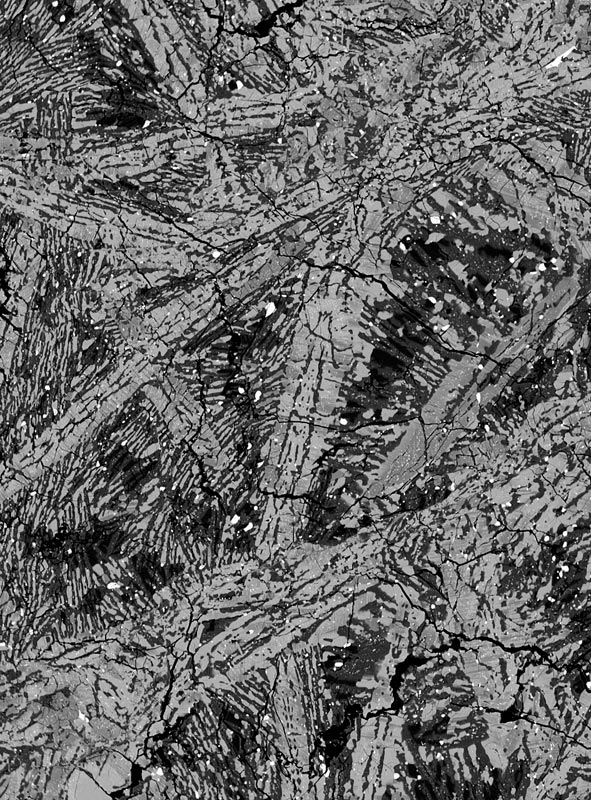
The group obtained a meteorite sample from Vesta that was originally discovered in Antarctica in 1981. The 50-gram sample, named ALHA81001, retains exceptional magnetic properties that scientists have been examining for years. Fu and his colleagues managed to acquire a one-gram sample of the rock for analysis.
The team first examined the rock’s tiny crystals. When forming in a magnetic field, a rock’s ferromagnetic crystals align in the direction of a background field when the rock is heated. The group measured the alignment of these minerals, or the rock’s magnetic “moment.” The researchers progressively demagnetized the rock until they found the magnetization that they believed to be the oldest remnant of a magnetic field.
The group’s next step was to determine the age of the rock. To do that, UC Berkeley researcher David Shuster analyzed the meteorite for evidence of argon. An isotope of argon called argon-40 is produced from the natural decay of potassium-40. A common technique for determining a rock’s age is to heat the rock and measure the amount of argon-40 released: The more argon-40, the older a rock may be. Through this technique, the researchers determined that the Vesta meteorite is 3.7 billion years old.
However, because Vesta formed 4.5 billion years ago, any early dynamo must have decayed by the time the meteorite now known as ALHA81001 formed. So what is the origin of the field that magnetized this rock?
Fu and Weiss believe that an early dynamo likely magnetized the surface of Vesta within the first 100 million years of the asteroid’s history, magnetizing surface rocks that then persisted over billions of years. When ALHA81001 formed 3.7 billion years ago, it would have also become magnetized due to exposure to fields emanating from the surrounding crust.
Could the magnetization of Vesta’s rocks have been caused by anything other than a dynamo? To rule out other scenarios, the group analyzed the crystals in the meteorite sample to determine the rock’s cooling history. While large impacts might create a magnetic field, such impact-generated fields would only last a few tens of minutes, according to Fu — and if a rock were to become magnetized in such a short period of time, it would also cool equally quickly.
To determine the cooling history — and therefore the magnetization period — of the meteorite sample, the group examined the tiny crystals on the rock’s surface — a technique developed by Timothy Grove, a professor of geology at MIT and a co-author of this week’s Science paper. They found that the rock experienced two periods of cooling: an initial rapid cooling, which produced fine crystals with excellent magnetic recording properties, followed by a much longer period of cooling. This longer cooling phase, Fu believes, is proof that the magnetic field observed in the rock is likely due not to an impact, but to a longer-lived field such as that expected for a dynamo.
The evidence for a dynamo on Vesta lends support to the theory that other small bodies in the Solar System may also have harbored similar dynamos, says Christopher Russell, a professor of geophysics and space physics at the University of California at Los Angeles.
“The moon’s ancient dynamo is given added credibility by this measurement,” Russell says. “Another small body, Jupiter’s moon Ganymede, today appears to have an active dynamo in its core. This measurement makes that interpretation more credible as well.”
“Vesta is so interesting, because it’s one of these building blocks that eventually formed the planets, and this is a remnant that’s still preserved and didn’t end up forming a planet,” Fu says. “It’s only 500 kilometers across, but it actually had many of the same global processes that the Earth has.”



